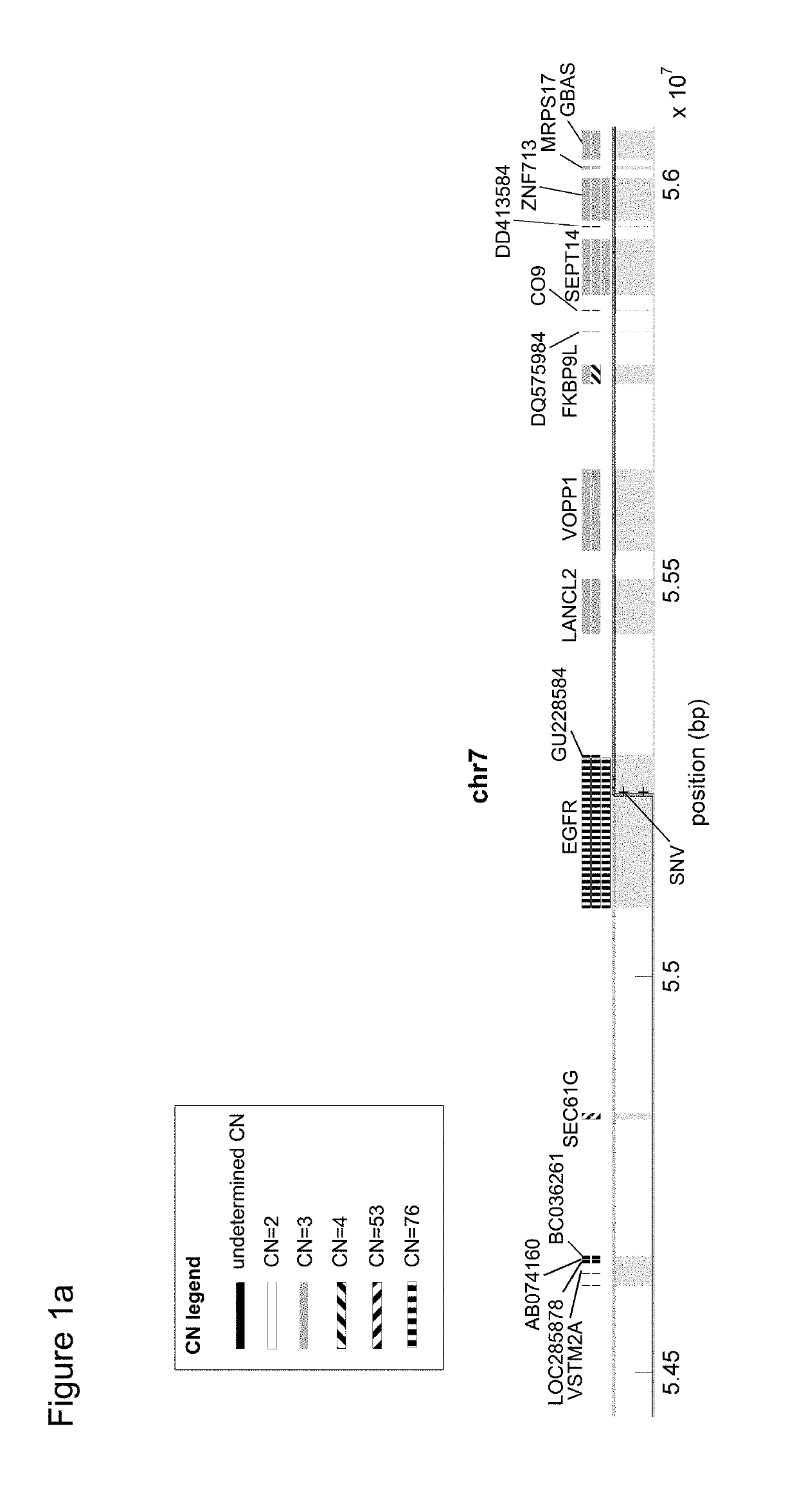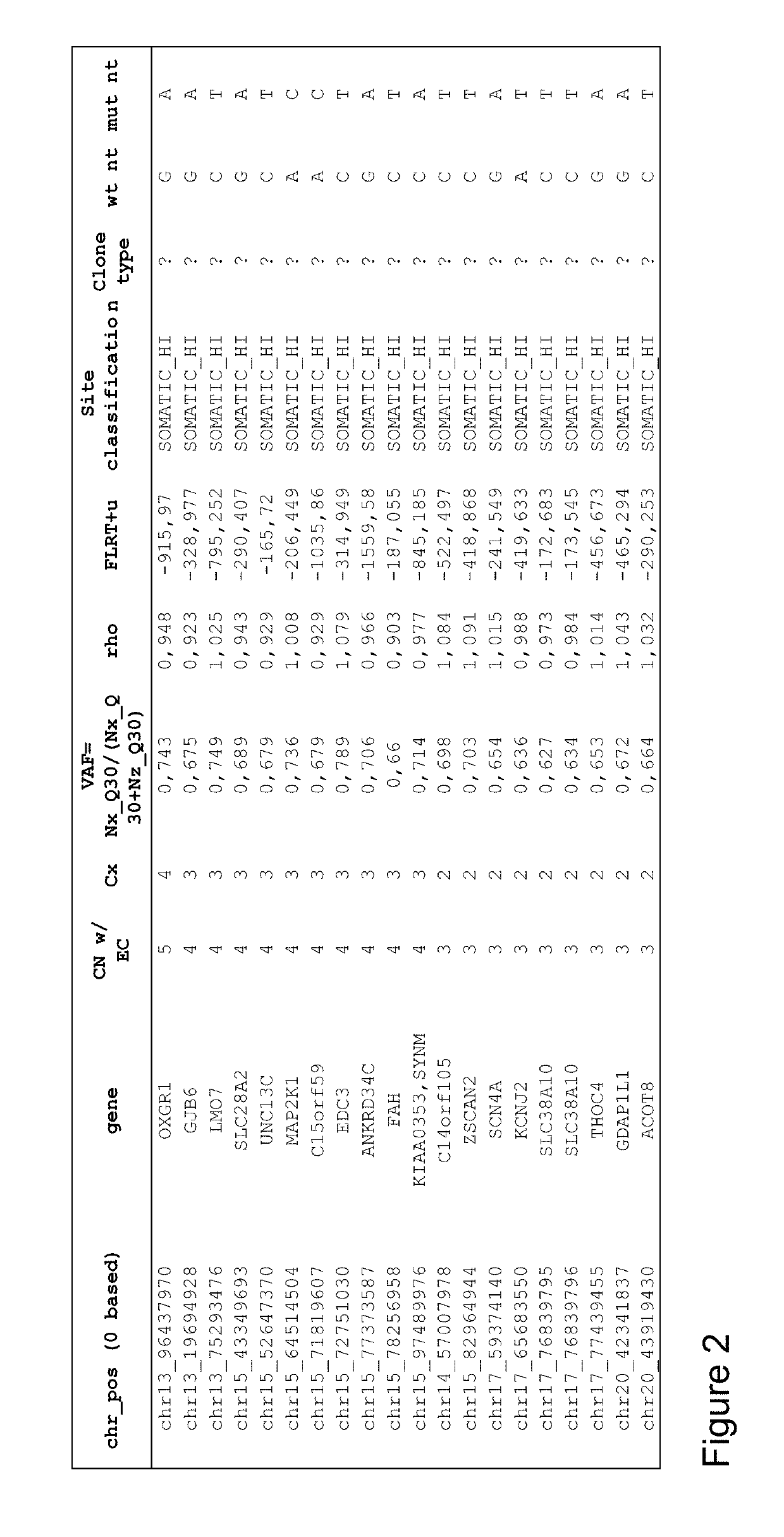Selecting Neoepitopes as Disease-Specific Targets for Therapy with Enhanced Efficacy
- Summary
- Abstract
- Description
- Claims
- Application Information
AI Technical Summary
Benefits of technology
Problems solved by technology
Method used
Image
Examples
example 1
TARGETING DISEASE-SPECIFIC MUTATIONS IN GENES WITH HIGH COPY NUMBER
[0284]Genomic information for glioblastoma sample (Chin et al., 2008, Comprehensive genomic characterization defines human glioblastoma genes and core pathways, Nature 455:1061-1068) was analyzed by looking for genes having a high copy number and in which at least one copy of the gene contained a disease-specific mutation. The quality analysis indicated that there was a high fidelity of copy number assignment for the 11,574 individual genes analyzed, and the ploidy of the genome of the sample was determined to be 1.95. FIG. 1a shows a graphical representation of the local genes surrounding epidermal growth factor receptor (EGFR) on chromosome 7, which is a known driver gene and have been a target for treatment. It was shown that EGFR in this genome had an error corrected absolute copy number of 76, of which 13 copies contained the disease-specific single nucleotide variation. FIG. 1b provides a list of the genes in t...
example 2
TARGETING DISEASE-SPECIFIC MUTATIONS WITH A HIGH ZYGOSITY
[0285]An exome obtained from a sample of melanoma cells from a tumor in a human was analyzed by looking for genes in which at least one copy of the gene has a disease-specific mutation and looking at the number of copies of the gene having the disease-specific mutation as well as the total number of copies of the gene, whether the gene has the mutation or not. FIG. 2 provides a list of genes sorted by zygosity in which the disease-specific mutation is found on multiple copies of the gene. For example, the disease-specific mutation in the OXGR1 gene has the highest zygosity (4), and in particular also has the highest fractional zygosity of 4 / 5 or 0.8 since there are a total of 5 copies of the OXGR1 gene and 4 of which copies contain the disease-specific mutation. The list provides 10 additional genes in which 3 copies of the gene out of a total of 4 copies have the mutation, indicating that the disease-specific mutation in thes...
example 3
TARGETING DISEASE-SPECIFIC MUTATIONS PRESENT IN ALL COPIES OF AN ESSENTIAL GENE
[0286]An exome obtained from a sample of melanoma cells from a tumor in a human was analyzed by looking for genes in which all copies of the gene have the same disease-specific mutation and determining which of these genes is an essential gene. The genes were determined to be essential by inferring their essentiality in humans from the knowledge that they are essential in mice (Georgi et al., 2013, From mouse to human: evolutionary genomics analysis of human orthologs of essential genes, PLoS Genetics 9 (5):e1003484; Liao et al., 2007, Mouse duplicate genes are as essential as singletons, Trends Genet. 23:378-381). FIG. 3 lists a number of genes in which all copies of the gene have the same disease-specific mutation. Moreover, the three highlighted genes were determined to be essential by inferring their essentiality from mouse data.
PUM
| Property | Measurement | Unit |
|---|---|---|
| Fraction | aaaaa | aaaaa |
| Immunogenicity | aaaaa | aaaaa |
Abstract
Description
Claims
Application Information
 Login to View More
Login to View More - R&D
- Intellectual Property
- Life Sciences
- Materials
- Tech Scout
- Unparalleled Data Quality
- Higher Quality Content
- 60% Fewer Hallucinations
Browse by: Latest US Patents, China's latest patents, Technical Efficacy Thesaurus, Application Domain, Technology Topic, Popular Technical Reports.
© 2025 PatSnap. All rights reserved.Legal|Privacy policy|Modern Slavery Act Transparency Statement|Sitemap|About US| Contact US: help@patsnap.com



